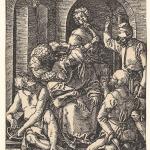The quadriga – the fourfold sense, consisting of literal, allegorical, tropological, and anagogical – isn’t only a “method” for interpreting Scripture but a framework for interpreting everything.
Two assumptions guide my reflections here. First, medieval biblical scholars insisted that biblical allegory and typology was not merely a method of textual interpretation but was a way of discerning the rhythms and rhymes of history. To say David’s life is an allegorical type of Christ’s life is not merely to say that the author of the gospel has deliberately arranged his presentation of Jesus to resemble David. It is rather to say that God’s work in history tend to be recapitulative and repetitive, not identically but non-identically. The Spirit sings the same songs over and over in different keys, so that we can discern the melodic shape of Christ in the song of David.
If this was true for the history recorded in Scripture, it remains true. The Father has uttered His final Word, sung it in flesh by the Wind of His Spirit, but history goes on, and similar patterns continue to be evident. If this is the case, then the mode of interpretation of Scripture should serve, roughly perhaps and loosely, as a template for the interpretation of history, the history of every and anything. Hence, we should be able to quadrigize mathematics and physics and sociology and psychology and whatever else.
Second, I am convinced that Gadamer is correct to emphasize the inseparability of interpretation and knowledge. Interpretation is not a second-order operation that we perform on the uninterpreted raw data gathered by the senses or worked out by pure reason. Interpretation is involved at every step of the process. We sense the world as; we construe it even as we sense it. That suggests that there is some value, as many theorists have argued in recent decades, to thinking of non-texts under the analogy of texts and to extend “hermeneutics” beyond its normal textual sphere into knowledge in general.
The use of the quadriga in this context is valuable for all the same reasons it is valuable for interpreting Scripture: It embeds Christological, ecclesial, and eschatological assumptions into the very process of interpretation. When we quadrigize a text, we find Christ there, but we also find the church as the body of Christ, and we learn how the text speaks to us as members of that body, and how it might direct us to hope for the final kingdom of Christ. When we quadrigize a non-biblical text, we are doing the same thing: We find Christ, we find the church, we find that it places demands on us, we discover ways that it might serve the final victory of Jesus.
When we read the Iliad, for instance, we pay close attention to the literal sense of the text, to its plotting and characters and poetic contours. But we are also seeking to find some glimmers of Christ in the text. For the Iliad, this might be largely negative: Achilles and Hector display a heroic ethic quite at odds with the heroism of Jesus. Yet that very contrast will illuminate the Iliad and its surrounding history; if nothing else, that very contrast will clarify the relativity of the heroic ethic of the Iliad and open the possibility of an alternative way. The Christological reflections on the text thus lead immediately into consideration of the tropological import: The Iliad becomes a site for reflecting on various conceptions of the heroic, and the epic becomes not merely a literary masterpiece but a text that in some fashion fashions the student. Finally, in every sense finally, the Iliad implies a certain trajectory to human history, a certain grim eschatology.
Quadrigizing the Iliad doesn’t mean forcing it into a Christian frame, far less approving the Homeric worldview or ethic. Rather: It provides a way to bring the story of heroic Greece into the story of the Bible.














